Priya Goyal
CLIP the Bias: How Useful is Balancing Data in Multimodal Learning?
Mar 07, 2024



Abstract:We study the effectiveness of data-balancing for mitigating biases in contrastive language-image pretraining (CLIP), identifying areas of strength and limitation. First, we reaffirm prior conclusions that CLIP models can inadvertently absorb societal stereotypes. To counter this, we present a novel algorithm, called Multi-Modal Moment Matching (M4), designed to reduce both representation and association biases (i.e. in first- and second-order statistics) in multimodal data. We use M4 to conduct an in-depth analysis taking into account various factors, such as the model, representation, and data size. Our study also explores the dynamic nature of how CLIP learns and unlearns biases. In particular, we find that fine-tuning is effective in countering representation biases, though its impact diminishes for association biases. Also, data balancing has a mixed impact on quality: it tends to improve classification but can hurt retrieval. Interestingly, data and architectural improvements seem to mitigate the negative impact of data balancing on performance; e.g. applying M4 to SigLIP-B/16 with data quality filters improves COCO image-to-text retrieval @5 from 86% (without data balancing) to 87% and ImageNet 0-shot classification from 77% to 77.5%! Finally, we conclude with recommendations for improving the efficacy of data balancing in multimodal systems.
* 32 pages, 20 figures, 7 tables
A Self-Supervised Descriptor for Image Copy Detection
Mar 25, 2022
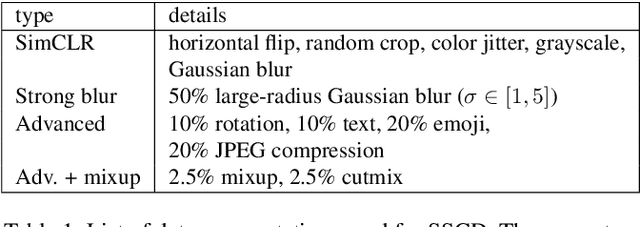
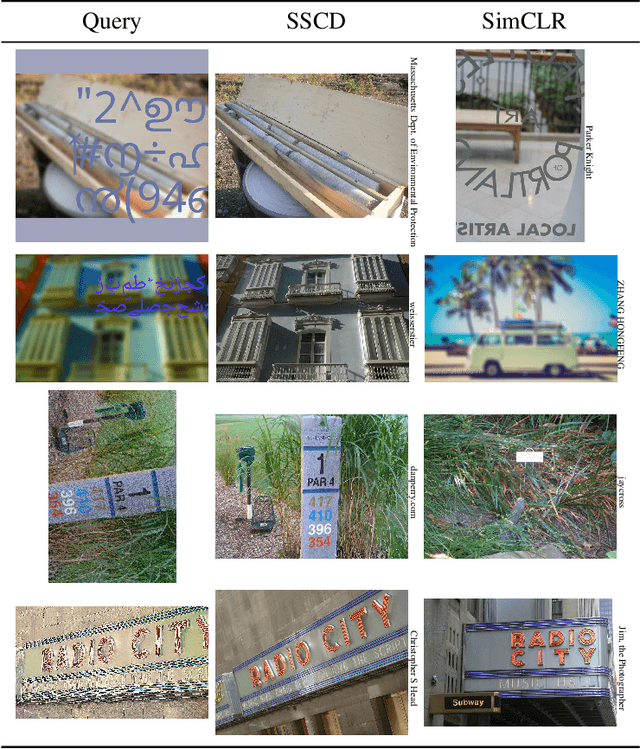
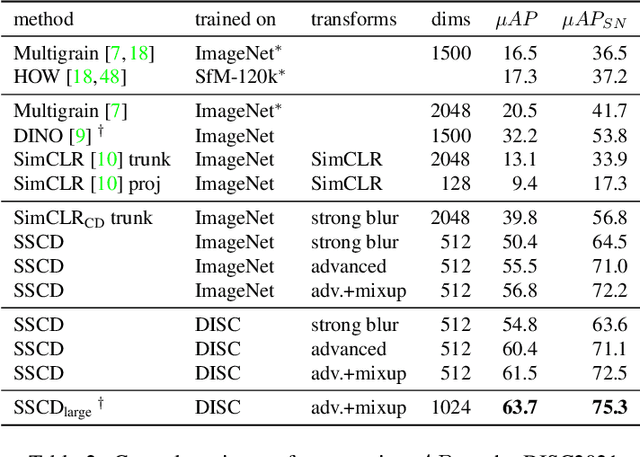
Abstract:Image copy detection is an important task for content moderation. We introduce SSCD, a model that builds on a recent self-supervised contrastive training objective. We adapt this method to the copy detection task by changing the architecture and training objective, including a pooling operator from the instance matching literature, and adapting contrastive learning to augmentations that combine images. Our approach relies on an entropy regularization term, promoting consistent separation between descriptor vectors, and we demonstrate that this significantly improves copy detection accuracy. Our method produces a compact descriptor vector, suitable for real-world web scale applications. Statistical information from a background image distribution can be incorporated into the descriptor. On the recent DISC2021 benchmark, SSCD is shown to outperform both baseline copy detection models and self-supervised architectures designed for image classification by huge margins, in all settings. For example, SSCD out-performs SimCLR descriptors by 48% absolute. Code is available at https://github.com/facebookresearch/sscd-copy-detection.
Vision Models Are More Robust And Fair When Pretrained On Uncurated Images Without Supervision
Feb 22, 2022



Abstract:Discriminative self-supervised learning allows training models on any random group of internet images, and possibly recover salient information that helps differentiate between the images. Applied to ImageNet, this leads to object centric features that perform on par with supervised features on most object-centric downstream tasks. In this work, we question if using this ability, we can learn any salient and more representative information present in diverse unbounded set of images from across the globe. To do so, we train models on billions of random images without any data pre-processing or prior assumptions about what we want the model to learn. We scale our model size to dense 10 billion parameters to avoid underfitting on a large data size. We extensively study and validate our model performance on over 50 benchmarks including fairness, robustness to distribution shift, geographical diversity, fine grained recognition, image copy detection and many image classification datasets. The resulting model, not only captures well semantic information, it also captures information about artistic style and learns salient information such as geolocations and multilingual word embeddings based on visual content only. More importantly, we discover that such model is more robust, more fair, less harmful and less biased than supervised models or models trained on object centric datasets such as ImageNet.
Fairness Indicators for Systematic Assessments of Visual Feature Extractors
Feb 15, 2022


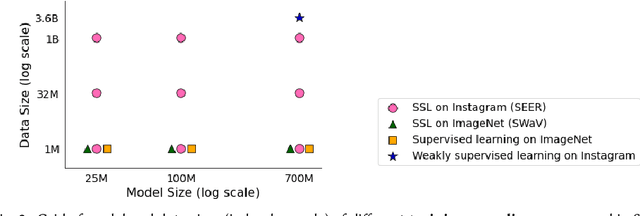
Abstract:Does everyone equally benefit from computer vision systems? Answers to this question become more and more important as computer vision systems are deployed at large scale, and can spark major concerns when they exhibit vast performance discrepancies between people from various demographic and social backgrounds. Systematic diagnosis of fairness, harms, and biases of computer vision systems is an important step towards building socially responsible systems. To initiate an effort towards standardized fairness audits, we propose three fairness indicators, which aim at quantifying harms and biases of visual systems. Our indicators use existing publicly available datasets collected for fairness evaluations, and focus on three main types of harms and bias identified in the literature, namely harmful label associations, disparity in learned representations of social and demographic traits, and biased performance on geographically diverse images from across the world.We define precise experimental protocols applicable to a wide range of computer vision models. These indicators are part of an ever-evolving suite of fairness probes and are not intended to be a substitute for a thorough analysis of the broader impact of the new computer vision technologies. Yet, we believe it is a necessary first step towards (1) facilitating the widespread adoption and mandate of the fairness assessments in computer vision research, and (2) tracking progress towards building socially responsible models. To study the practical effectiveness and broad applicability of our proposed indicators to any visual system, we apply them to off-the-shelf models built using widely adopted model training paradigms which vary in their ability to whether they can predict labels on a given image or only produce the embeddings. We also systematically study the effect of data domain and model size.
Self-supervised Pretraining of Visual Features in the Wild
Mar 05, 2021



Abstract:Recently, self-supervised learning methods like MoCo, SimCLR, BYOL and SwAV have reduced the gap with supervised methods. These results have been achieved in a control environment, that is the highly curated ImageNet dataset. However, the premise of self-supervised learning is that it can learn from any random image and from any unbounded dataset. In this work, we explore if self-supervision lives to its expectation by training large models on random, uncurated images with no supervision. Our final SElf-supERvised (SEER) model, a RegNetY with 1.3B parameters trained on 1B random images with 512 GPUs achieves 84.2% top-1 accuracy, surpassing the best self-supervised pretrained model by 1% and confirming that self-supervised learning works in a real world setting. Interestingly, we also observe that self-supervised models are good few-shot learners achieving 77.9% top-1 with access to only 10% of ImageNet. Code: https://github.com/facebookresearch/vissl
Unsupervised Learning of Visual Features by Contrasting Cluster Assignments
Jul 17, 2020



Abstract:Unsupervised image representations have significantly reduced the gap with supervised pretraining, notably with the recent achievements of contrastive learning methods. These contrastive methods typically work online and rely on a large number of explicit pairwise feature comparisons, which is computationally challenging. In this paper, we propose an online algorithm, SwAV, that takes advantage of contrastive methods without requiring to compute pairwise comparisons. Specifically, our method simultaneously clusters the data while enforcing consistency between cluster assignments produced for different augmentations (or views) of the same image, instead of comparing features directly as in contrastive learning. Simply put, we use a swapped prediction mechanism where we predict the cluster assignment of a view from the representation of another view. Our method can be trained with large and small batches and can scale to unlimited amounts of data. Compared to previous contrastive methods, our method is more memory efficient since it does not require a large memory bank or a special momentum network. In addition, we also propose a new data augmentation strategy, multi-crop, that uses a mix of views with different resolutions in place of two full-resolution views, without increasing the memory or compute requirements much. We validate our findings by achieving 75.3% top-1 accuracy on ImageNet with ResNet-50, as well as surpassing supervised pretraining on all the considered transfer tasks.
Scaling and Benchmarking Self-Supervised Visual Representation Learning
Jun 06, 2019



Abstract:Self-supervised learning aims to learn representations from the data itself without explicit manual supervision. Existing efforts ignore a crucial aspect of self-supervised learning - the ability to scale to large amount of data because self-supervision requires no manual labels. In this work, we revisit this principle and scale two popular self-supervised approaches to 100 million images. We show that by scaling on various axes (including data size and problem 'hardness'), one can largely match or even exceed the performance of supervised pre-training on a variety of tasks such as object detection, surface normal estimation (3D) and visual navigation using reinforcement learning. Scaling these methods also provides many interesting insights into the limitations of current self-supervised techniques and evaluations. We conclude that current self-supervised methods are not 'hard' enough to take full advantage of large scale data and do not seem to learn effective high level semantic representations. We also introduce an extensive benchmark across 9 different datasets and tasks. We believe that such a benchmark along with comparable evaluation settings is necessary to make meaningful progress. Code is at: https://github.com/facebookresearch/fair_self_supervision_benchmark.
Tensor Comprehensions: Framework-Agnostic High-Performance Machine Learning Abstractions
Jun 29, 2018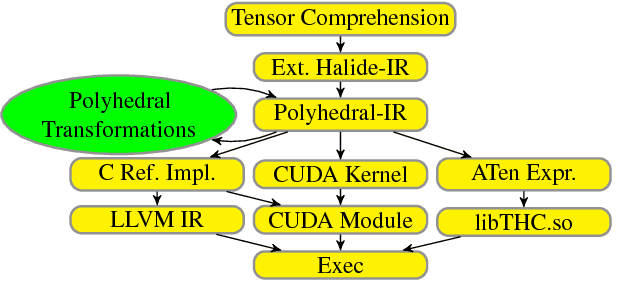
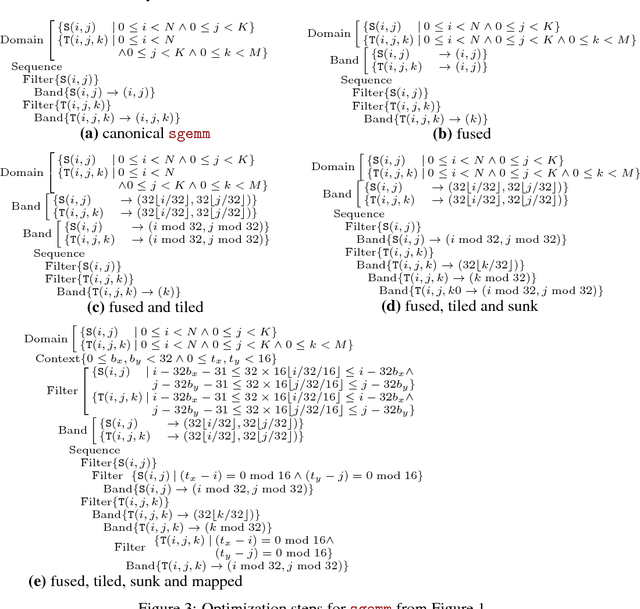
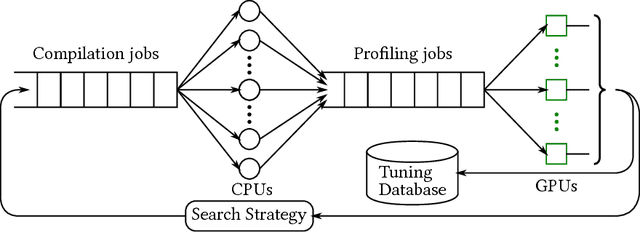
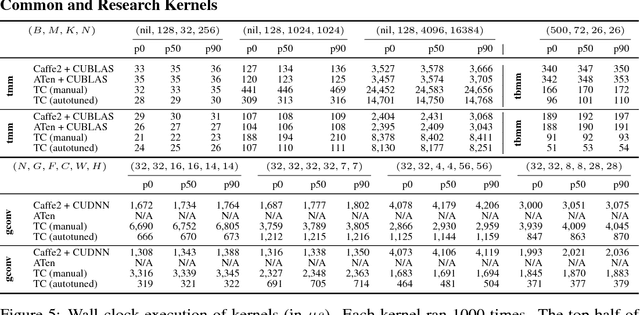
Abstract:Deep learning models with convolutional and recurrent networks are now ubiquitous and analyze massive amounts of audio, image, video, text and graph data, with applications in automatic translation, speech-to-text, scene understanding, ranking user preferences, ad placement, etc. Competing frameworks for building these networks such as TensorFlow, Chainer, CNTK, Torch/PyTorch, Caffe1/2, MXNet and Theano, explore different tradeoffs between usability and expressiveness, research or production orientation and supported hardware. They operate on a DAG of computational operators, wrapping high-performance libraries such as CUDNN (for NVIDIA GPUs) or NNPACK (for various CPUs), and automate memory allocation, synchronization, distribution. Custom operators are needed where the computation does not fit existing high-performance library calls, usually at a high engineering cost. This is frequently required when new operators are invented by researchers: such operators suffer a severe performance penalty, which limits the pace of innovation. Furthermore, even if there is an existing runtime call these frameworks can use, it often doesn't offer optimal performance for a user's particular network architecture and dataset, missing optimizations between operators as well as optimizations that can be done knowing the size and shape of data. Our contributions include (1) a language close to the mathematics of deep learning called Tensor Comprehensions, (2) a polyhedral Just-In-Time compiler to convert a mathematical description of a deep learning DAG into a CUDA kernel with delegated memory management and synchronization, also providing optimizations such as operator fusion and specialization for specific sizes, (3) a compilation cache populated by an autotuner. [Abstract cutoff]
Accurate, Large Minibatch SGD: Training ImageNet in 1 Hour
Apr 30, 2018



Abstract:Deep learning thrives with large neural networks and large datasets. However, larger networks and larger datasets result in longer training times that impede research and development progress. Distributed synchronous SGD offers a potential solution to this problem by dividing SGD minibatches over a pool of parallel workers. Yet to make this scheme efficient, the per-worker workload must be large, which implies nontrivial growth in the SGD minibatch size. In this paper, we empirically show that on the ImageNet dataset large minibatches cause optimization difficulties, but when these are addressed the trained networks exhibit good generalization. Specifically, we show no loss of accuracy when training with large minibatch sizes up to 8192 images. To achieve this result, we adopt a hyper-parameter-free linear scaling rule for adjusting learning rates as a function of minibatch size and develop a new warmup scheme that overcomes optimization challenges early in training. With these simple techniques, our Caffe2-based system trains ResNet-50 with a minibatch size of 8192 on 256 GPUs in one hour, while matching small minibatch accuracy. Using commodity hardware, our implementation achieves ~90% scaling efficiency when moving from 8 to 256 GPUs. Our findings enable training visual recognition models on internet-scale data with high efficiency.
Focal Loss for Dense Object Detection
Feb 07, 2018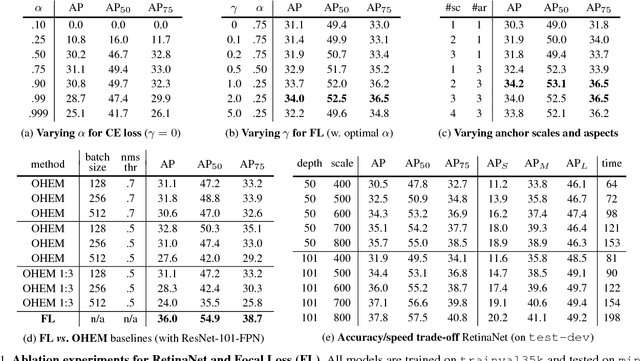


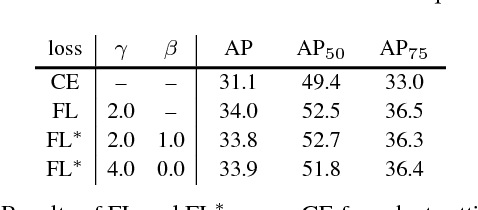
Abstract:The highest accuracy object detectors to date are based on a two-stage approach popularized by R-CNN, where a classifier is applied to a sparse set of candidate object locations. In contrast, one-stage detectors that are applied over a regular, dense sampling of possible object locations have the potential to be faster and simpler, but have trailed the accuracy of two-stage detectors thus far. In this paper, we investigate why this is the case. We discover that the extreme foreground-background class imbalance encountered during training of dense detectors is the central cause. We propose to address this class imbalance by reshaping the standard cross entropy loss such that it down-weights the loss assigned to well-classified examples. Our novel Focal Loss focuses training on a sparse set of hard examples and prevents the vast number of easy negatives from overwhelming the detector during training. To evaluate the effectiveness of our loss, we design and train a simple dense detector we call RetinaNet. Our results show that when trained with the focal loss, RetinaNet is able to match the speed of previous one-stage detectors while surpassing the accuracy of all existing state-of-the-art two-stage detectors. Code is at: https://github.com/facebookresearch/Detectron.
 Add to Chrome
Add to Chrome Add to Firefox
Add to Firefox Add to Edge
Add to Edge